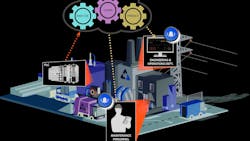The Digital Thread in Process Industries
Process manufacturers live in a highly regulated, risk-averse and occasionally volatile world. Those operational factors are a primary reason why the digitization of process industries have lagged far behind the discrete manufacturers.
As Machine Design reported this week, a new testbed project unveiled July 28 highlighted how Dow and Siemens put a new face on the use of digital tools to measure, manage and optimize process manufacturing. Company officials worked with MxD, the digital innovation center in Chicago, to develop a web-based system to employ simulation, system management and maintenance of process plants.
“This is what Industry 4.0 is going to look like for process industries,” said Raj Batra, president of Digital Industries for Siemens USA at a press conference at MxD. “The digital thread is going to unlock innovation and accelerate the time to market. What’s being done here is very scalable for industry.”
There are significant implications of a more digital process market from the aspects of capital investments, safety and supplies. All of them need to be part of a conversation within process manufacturing. The proof cases exist to bring process manufacturing into the digital age.
Keeping Process Industries Online
One of the big challenges of cloud computing in the process industry is reliability, which is why major cloud providers have focused on a redundant system that can stay online regardless of local conditions, according to a new Machine Design article.
“End-users also have options for defining how and where data is stored and processed. Critical data can be replicated in different regions so that if there is a catastrophe, nothing is lost. Redundancy is critical to many operations, but for many on-premises applications the redundant servers are in the same physical location.
With cloud computing, the redundant servers can be located in different parts of the country, or the world. This geographic diversity greatly improves the chances of staying operational in the event of a power outage, natural disaster and other unexpected disruption of service,” writes Damon Purvis of AutomationDirect.
